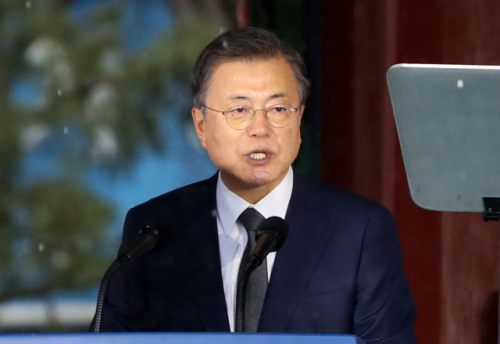[‘원칙’ 고수하면서…日과 대화한다는 文]
Despite mention of “Tokyo Olympics cooperation”… Coronavirus outbreak crisis
Next year, Korea-presidential election, Japan-House of Representatives elections ahead
Lack of physical time due to internal and external variables… Prospective approach
 viewer
viewer
 viewer
viewer
The future-oriented Korea-Japan cooperation relationship that President Moon Jae-in emphasized in the March 1 commemoration address is expected to become a’empty resonant’ within the current government’s term of office. Apart from President Moon’s will to improve relations between Korea and Japan, no concrete solution has been proposed to resolve the conflict between Korea and Japan. Furthermore, it is uncertain whether the Tokyo Olympics, which President Moon mentioned as the momentum of dialogue, as well as the Korea-Japan Summit, where you can have open-hearted dialogue, will be held due to the new coronavirus infection (Corona 19). Some analysts say that Korea and Japan, which are scheduled for the House of Representatives, have no physical time to focus on normalizing relations between Korea and Japan. Experts point out that it is impossible to improve Korea-Japan relations unless the leaders of the two countries take a forward-looking approach with strong will.
President Moon attended a ceremony to commemorate March 1 of the 102nd anniversary held at Tapgol Park in Jongno-gu, Seoul on the 1st, and brought out a message to Japan in a softer tone than the previous speech. It is based on the judgment that only by resolving the Korean-Japanese crunch can reactivate the peace process on the Korean peninsula and meet the stance of Joe Biden’s “trilateral cooperation between the United States and Korea”. President Moon took a step further from last year’s message, “I will not forget the past, but will not stay in the past,” he said on the day, saying, “Our government is always ready to sit face to face with the Japanese government to have a conversation.” It can be evaluated as an appeasing message that emphasized the point of’willingness to talk with Japan’, but the limitation seems clear in that it did not provide a practical solution to the conflict between Korea and Japan. Jin Chang-soo, a senior research fellow at the Sejong Institute, said, “I think it is a rehash of what we have been talking about.”
In fact, overall, there was no change in President Moon’s approach to the issue of Japan and Korea. This is because it adheres to the existing two-track strategy, which says,’We will respond to issues of the past, such as forced conscription and damage to comfort women, in isolation from the issue of mutually beneficial development between Korea and Japan.’ President Moon emphasized, “We need to focus more on future-oriented development while solving the past problems according to the past problems.” Although it is in conflict with Japan, which has a one-track strategy that retaliated against the Korean Supreme Court’s ruling in compensation for compulsory conscription due to export restrictions, it has failed to come up with a trick to solve the problem.
There was no solution to the problem of monetizing the assets of Japanese forced labor companies. Earlier, at a New Year’s press conference in January, President Moon mentioned the necessity of a diplomatic solution, saying, “I do not think that the issue of compulsory conscription is converted into cash through forced execution or that the ruling is realized in Korea-Japan relations.” Accordingly, a full-scale diplomatic compromise was expected by the Korean and Japanese governments, but no remarks could be found suggesting this.
 viewer
viewer
President Moon also maintained the principle of’victimism’. “The Korean government will always seek a wise solution from the standpoint of victim-centredism,” he said. It is clear that it is necessary to listen to the voices of the victims of forced labor and comfort women, but it has maintained the existing attitude that can evoke a strong relationship with Japan.
The problem is that creating a dialogue table with Japan can be realistically difficult. In his commemorative address, President Moon said, “It could be an opportunity for dialogue between Korea and Japan, North Korea, North Korea, and North America,” referring to the Tokyo Summer Olympics scheduled for July. “Korea will cooperate for the successful hosting of the Tokyo Olympics,” he said.
However, it is pointed out that the Corona 19 incident acts as a variable and the possibility of reality is low. Kookmin University professor Lee Won-deok predicted, “It is unlikely that the Tokyo Olympics will be held due to the corona crisis.” Professor Lee said, “If the Tokyo Olympics cannot be held, the Suga cabinet loses the basis for its existence, and the general resignation will be held and the general election will be held in March-April. “I think it will be difficult to make a decision to improve the relationship between Korea and Japan.”
The domestic political timetable is also an obstacle. The election phase for the March 2022 presidential election will heat up after the by-election of the mayors of Seoul and Busan ends on the 7th of next month. In the end, the weight of the observation that President Moon cannot resolve the conflict between Korea and Japan and the term of office may end. Professor Lee said, “Since Korea has a presidential election as Korea and running to a lame duck, the time to decide to resolve the issues between Korea and Japan becomes ambiguous,” he said. “What we can do now is to manage the relationship so that it does not deteriorate any more.”
/ Reporter Heo Se-min [email protected], Reporter Kim In-yeop [email protected]
< 저작권자 ⓒ 서울경제, 무단 전재 및 재배포 금지 >
